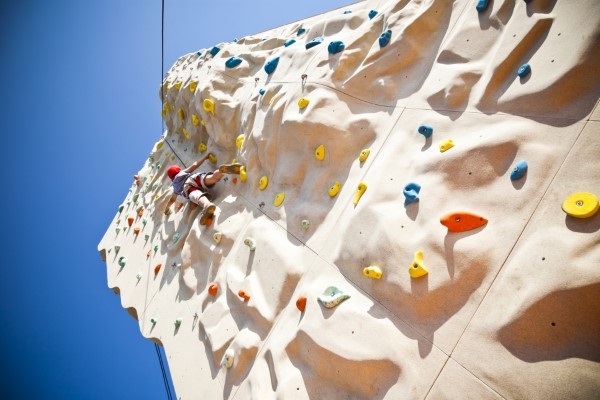Rides and amusement devices

Mechanical devices used for rides and entertainment at carnivals, shows and events are known as amusement devices.
When is Council approval required for an amusement device?
Council approval is required for medium and large amusement devices erected and operated in the Tweed.
Amusement devices must meet Australian safety standards. Registration is managed by SafeWork NSW.
Amusement devices include:
- ferris wheels and roller coasters
- go-karts
- climbing walls
- giant slides
- inflatable devices (land and water-borne)
- bungy jumping, bridge swinging and high ropes courses
- most manually operated mechanical devices (powered and unpowered)
- miniature trains not owned or operated by a model railway society, club or association.
Note - The proposed event may require separate Council approval (such as development consent or a community event licence) – see below.
When are amusement devices not permitted?
Amusement devices (including jumping castles) and horse rides are not allowed for private parties on Council owned land.
What amusement devices are exempt from approvals?
The following amusement devices may be installed and operated without Council approval on private land. They may also be used in community events on public land approved by Council if specified as part of the event licence application or development application.
Exempt devices
- jumping castles/inflatable devices (other than inflatable devices (continuously blown) with a platform height of 3 meters or more)
- water slides
- wave generators
- devices operated by manual power.
These devices do not need to be registered under the Work Health and Safety Regulation 2017.
Small amusement devices
Small amusement devices means an amusement device that is designed primarily for the use of children 12 years of age or under, such as:
- mini-Ferris wheels
- rotating amusement devices (with a maximum rotation of 14 revolutions per minute)
- battery operated cars, and miniature trains and railway systems (owned and operated by model railway societies) – designed for children 12 years or under.
Small amusement devices must be installed and operated in accordance with the requirements of Section 75 of the Local Government (General) Regulation 2021.
Standards to be met for approval
- the ground or other surface on which the device is to be or has been erected is sufficiently firm to sustain the device while it is in operation and is not dangerous because of its slope or irregularity or for any other reason; and
- the device is registered under the Work Health and Safety Regulation 2017; and
- the device:
(i) is to be or has been erected, and
(ii) it to be or is being operated,
in accordance with all conditions (if any) relating to its erection or operation set out in the current certificate of registration issued for the device under that Regulation; and
- there exists for the device a current log book as referred to in that Regulation, Chapter 5, Part 5.2, Division 4, Subdivision 2; and
- in the case of a device that is to be or is installed in a building, fire egress is not obstructed; and
- there is in force a contract of insurance or indemnity for the device that complies with section 74.
Event organisers – responsibilities
When hosting events that include amusement devices, event organisers should refer to the Duties of event organisers guide.
Other Council approvals may be required for proposed events (such as development consent or a community event licence).
For more general information see holding and promoting events.
Apply to install or operate an amusement device

Council approval is required before amusement devices can be erected and operated in the Tweed.
If you are hiring an amusement device you should check that the operator has all the required approvals.
Approvals are required under Section 68 of the Local Government Act 1993.
Before you apply
Before you apply you must consider the following.
- Event planning – applications must be submitted at least 6 weeks before the proposed event.
- Associated approvals may be required, for example development consent and community event licence.
- Public liability insurance – to find out the minimum level of public liability insurance needed for your application contact Council’s Corporate Governance Unit on 02 6670 2400. The Certificate of Currency must list Council as an Interested Party and suitably identify the proposed device.
- Site conditions – you need to provide certification from a qualified structural engineer that:
- the ground or other surface on which the device is to be or has been erected is sufficiently firm to sustain the device while it is in operation and will not be dangerous because of its slope or irregularity or for any other reason
- the device once erected is capable of resisting loads identified within the relevant Australian standards including AS/NZS 1170.0, AS/NZS 1170.1, and AS/NZS 1170.2.
Certification must consider the location of any structures, services and utilities (including Council’s water and sewer mains). A Certificate of Currency for professional indemnity insurance for the engineering firm (minimum $5 million) must also be included.
Documentation
The following amusement device documentation is required:
- device registration certificate
- engineer and electrician reports
- annual inspections and compliance with AS3533
- current logbook
- confirmation that the device will be erected, operated and maintained in accordance with the manufacturer’s operating procedure
- confirmation that staff are fully trained and use correct PPE.
Submit your application
Fill out the application form(PDF, 218KB) and pay the fee (see fees and payments).
Contact us
For enquiries about approvals for amusement devices call Council’s Environmental Health Unit on 02 6670 2400.
SafeWork NSW
Safety checks should be completed before an amusement device is put into service. Devices must be safe for operators and patrons.
SafeWork NSW is responsible for amusement device registration and general information. Call 13 10 50 or visit SafeWork NSW.